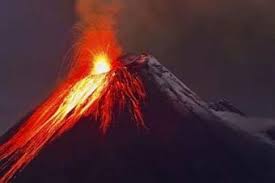27 Jul 2022 Japan’s Sakurajima Volcano

- Recently, the Sakurajima volcano in Japan’s main western island of Kyushu saw an eruption.
- In the year 2021, the Fukutoku-Okanoba Submarine Volcano erupted in the Pacific Ocean off Japan.
Sakurajima Volcano
- Sakurajima is one of Japan’s most active volcanoes and has had various levels of eruptions on a regular basis.
- This is an active Strato Volcano.
- Historically the largest eruptions at Sakurajima occurred during the years 1471–76 and in 1914.
- Eruptions in it have been recorded from the 8th century.
- Due to its continuous accumulation of ash on Kagoshima and its explosive potential, it is considered one of the most dangerous volcanoes.
Volcano:
- A volcano is an opening or rupture in the Earth’s surface that ejects hot liquid and semi-liquid rocks, volcanic ash and gases in the form of magma.
- The remaining material causes a volcanic eruption. This can lead to a rapid explosion, which leads to the release of a large amount of material.
- Exploded material on Earth can be liquids (“lava” when it’s on the surface, “magma” when it’s underground), ash and/or gas.
Reason for rise in magma:
- Ejection of magma occurs when Earth’s tectonic plates undergo convergent motion. Magma rises to fill the void. When this happens, the process of volcanic formation can also take place under water.
- When these tectonic plates move towards each other, magma also rises and parts of the plate go deep into its interior, due to high temperature and pressure, the crust melts and rises up as magma.
- Magma finally rises above the hot-spot. Hot-spots are hot regions inside the Earth. These regions heat the magma. When this magma is less dense it rises up. Although the causes of magma uplift vary, they may each have the potential to form a volcano.
Type:
Shield Volcano:
- This volcano produces low viscosity, flowing lava that extends far from the source and forms a volcano with a mild slope.
- Most shield volcanoes are formed from fluid, basaltic lava flows.
- Mauna Kea and Mauna Loa are shield volcanoes. They are the largest active volcanoes in the world around the Hawaiian Islands.
Strato Volcano:
- Strato volcanoes have relatively steep slopes and are more cone-shaped than shield volcanoes.
- They are formed from viscous, viscous lava that does not flow easily.
Lava dome:
- Soufriere mountain volcano on the Caribbean island of Montserrat, known for its lava dome complex at the summit of the volcano, has gone through phases of growth and collapse. Since viscous lava is not very liquid, it cannot easily move far beyond the exhaust hole when it is expelled. Instead it accumulates in the form of a pile at the top of the vent which forms a dome shaped structure.
Caldera:
- Magma is deposited in the magma chamber under the volcano. When a volcanic eruption occurs, magma is expelled out of the chamber, causing the magma to form a depression or bowl-like structure with vertical walls on the roof surface of the chamber.
- These are calderas and can be tens of miles apart.
Volcanoes in India:
- Barren Island, Andaman Islands (India’s only active volcano)
- Narcondam, Andaman Islands
- Baratang, Andaman Islands
- Deccan Traps, Maharashtra
- Dhinodhar Hills, Gujarat
- Dhosi Hills, Haryana


No Comments